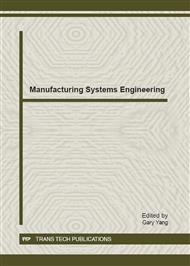[1]
R. Haralick and L. Shapiro, Image Segmentation Techniqus, Journals of Computer Vision, Graphics, and Image Processing, vol. 29, pp.100-132, (1985).
DOI: 10.1016/s0734-189x(85)90153-7
Google Scholar
[2]
S. Sclaroff, L. Liu, Deformable Shape Detector and Description via Model-Based Grouping, IEEE Transaction Pattern Analysis and Machine Intelligence, vol. 23, pp.475-488, (2001).
DOI: 10.1109/34.922706
Google Scholar
[3]
F. Kurugollu, B. Sankur, A. Harmanci, Color image segmentation using histogram multithresholding and fusion, image and Vision Computing, vol. 19, pp.915-928, (2001).
DOI: 10.1016/s0262-8856(01)00052-x
Google Scholar
[4]
Sookpotharom S, Border Detection of Skin Lesion Images Based on Fuzzy C-Means Thresholding, International Conference on Genetic and Evolutionary Computing, pp.777-780, (2009).
DOI: 10.1109/wgec.2009.96
Google Scholar
[5]
M. Clebi, H. Kingravi, J . Lee, Fast and Accurate Border Detection in Dermoscopy Images Using Statistical Region Merging, Proceeding of SPIE Medical Imaging, San Diego, CA, USA, vol. 2, pp.17-22, (2007).
DOI: 10.1117/12.709073
Google Scholar
[6]
M. Kass, A. Witkin, and D. Terzopoulos, Snakes – Active Contour Models, International Journal of Computer Vision, vol. 11, pp.321-331, (1987).
DOI: 10.1007/bf00133570
Google Scholar
[7]
T. Chan, L.A. Vese, Active contours without edges, IEEE Trans-actions on image processing, vol. 10, pp.266-277, (2001).
DOI: 10.1109/83.902291
Google Scholar
[8]
V. Caselles, R. Kimmel, G. Sapiro, Geodesic Active Contours, International Journal of Computer Vision, vol. 22, pp.61-79, (1997).
DOI: 10.1109/iccv.1995.466871
Google Scholar
[9]
Xiaofeng Wang, A Novel Multi-Layer Level Set Method for Image segmentation, Journal of Universal Computer Science, vol. 14, pp.2428-2452, (2008).
Google Scholar
[10]
S. Osher and C. Shu, High-order nonoscillatory schemes for Hamilton–Jacobi equations, Comput. Phys, vol. 28, 907-922, August, (1991).
DOI: 10.1137/0728049
Google Scholar
[11]
G. Aubert, P. Kornprobst, Mathematical Problems in Image Processing: Partial Differential Equations and the Calculus of Variations, New York: Springer, (2002).
DOI: 10.1007/b97428
Google Scholar
[12]
Sagiv C, Sochen N A, Zeevi Y Y, Integrated active contours for texture segmentation, IEEE, IP, (2005).
DOI: 10.1109/tip.2006.871133
Google Scholar
[13]
T.F. Chan, B.Y. Sandberg, L.A. Vese, Active contours without edges for vector-valued images, Visual Communication and Image Representation, vol. 11, pp.130-141, (2000).
DOI: 10.1006/jvci.1999.0442
Google Scholar
[14]
D. Mumford, J. Shan, Optimal approximation, by piece-wise smoothes functions and associated variational problems, Communications on pure and applied mathmatics, vol. 42, pp.677-685, (1989).
Google Scholar
[15]
J.A. Sethian, Numerical methods for propagating fronts in Variational Methods for Free Surface Interfaces, edited by P. Concus and R. Finn , Springer-Verlag, New York, (1987).
DOI: 10.1007/978-1-4612-4656-5_18
Google Scholar


